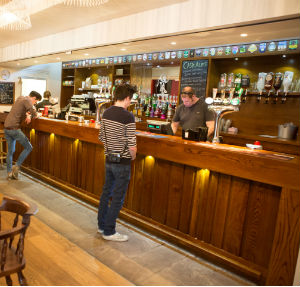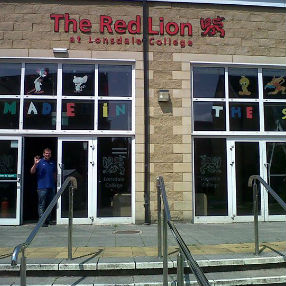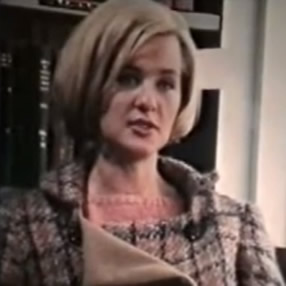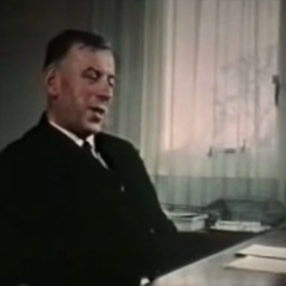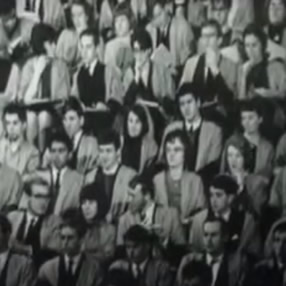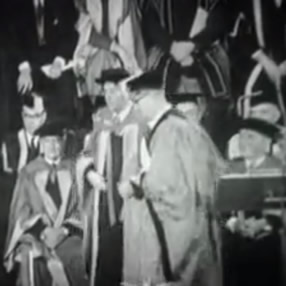Remember When
Here are some of the people and events that have made the University what it is today.
Send your memories and anecdotes (max 300 words plus a high resolution photograph) to alumni@lancaster.ac.uk.
We’ll include as many as we can.
The Establishment of Bowland College
One of two founding colleges, the establishment of Bowland College was confirmed, alongside Lonsdale, by the Lancashire County Council in 1965. Named after the Forest of Bowland in north Lancashire, which is “An Area of Outstanding Natural Beauty”, the College proudly pays tribute to its namesake with its logo, the Bowland Lady.
The Bowland Lady personifies the forest and her image comes from a Lancashire map drawn by William Hole for a poem published in 1622. A copy of the poem, ‘Poly Olbion, or a Chorographical Description of… The Renowned Isle of Great Britain’, resides in the University library and the map is displayed in the college bar.
Bowland College lies at the heart of campus and was one of the first colleges to be built on the Bailrigg campus with many students moving in from their old residences in the Waring and Gillow Factory. Many of the college’s facilities were refurbished in 2011, including the Trough of Bowland which currently holds the prominent status of the oldest college bar on campus. In addition to this, the frontage of the physical Bowland College building was converted into the Learning Zone at the cost of £2.5 million and opened by Sir Alan Langland in January 2010. More recently, the University celebrated the refurbishment and reopening of Bowland Tower, which was completed this January to a very high standard and retains the title of tallest building on campus standing at fourteen storeys high and originally designed to disguise the University’s boiler room chimney. Bowland has also remained central to the interests of students housing the Students’ Union since at least the 1990s in Slaidburn House and then moving to Bowland Main with refurbished offices in time for the start of the 2013 academic year.
With the stirring motto of ‘Bowland Till I Die’, members of Bowland compete in various inter college sporting events such as the Carter Shield and Bowland alumni flock to their home college every summer for the glory of Founders – an annual competition between Bowland and Lonsdale as the first of Lancaster’s colleges. Alumni of Bowland College include Matthew Fort, TV Food Critic and Journalist (English 1968), Mark Price, Managing Director, Waitrose (Classics and Archaelogy, 1982) and Jason Queally MBE, Olympic Gold Medal Cyclist (Biological Sciences, 1992).
The Establishment of Lonsdale College
Lonsdale College, one of the two founding colleges, is also celebrating its 50th birthday this year and remains to be one of the largest colleges on campus. Like many of the others, it is named after a region of the traditional county of Lancashire and the Lonsdale area, the valley of the River Lune. With a cry of ‘simply the best!’, Lonsdale is represented by the colloquially known Lonnie Lion on its logo.
In the early years of the college system, the colleges were unsure of their role in University life. In a statement of intent produced by the college in 1966, the college’s main aims were defined as being: to provide a means of expression for the academic staff in general matters of university policy and a basis for an academic life transcending that of the department, to provide a focus of communal life and to provide for the welfare of junior members through both the tutorial system and the maturing influence of corporate life, while avoiding the sacrifice of their personal liberty.
Lonsdale was originally located in what is now known as Bowland North and was designed in tandem with Bowland. In 2004, Lonsdale was relocated alongside Cartmel to the newly built development in Alexandra Park and the original buildings were given to Bowland. For forty years, Lonsdale was home to the Law department and the Modern Language department, but as the University entered the 2000s, the role and location of Lonsdale College changed. Lonsdale has a longstanding reputation as the ‘party college’, with some of the most popular social events held on campus – the end of the year Extrav parties held by the colleges in summer term are always extremely popular for Lonsdale.
Lonsdale bar was recently renamed ‘The Red Lion’ in order to incorporate the logo. The college magazine – the Purple Lonnie (although it is currently named Roar) - enjoys a claim to fame, as the name comes from an encounter with the popular Purple Ronnie character used in greetings cards and who was included in an advertising campaign for Vimto. A parent of a JCR member worked for the company that created the Purple Ronnie poems and when asked to pen a Purple Ronnie poem for Lonsdale, it came back signed ‘Purple Lonnie’!
Early students discussing why they chose Lancaster University
A number of early students from the 1960s discuss why they chose Lancaster.
The Role of the University in the 1960s
The first Vice Chancellor of Lancaster University Charles Carter discusses the role of Lancaster University and where it sits within 1960s England.
Princess Alexandra's inauguration as Chancellor of Lancaster University
Lancaster was one of the last of 'new' universities to be authorized by the government. Princess Alexandra became the Chancellor of the University and was inaugurated in 1964.
Harold Wilson's Acceptance Speech
The opening ceremony of the University saw the granting of various honorary degrees to amongst others, the new Prime Minister Harold Wilson. Wilson delivered his speech only a short time after his election win with the Labour party.


